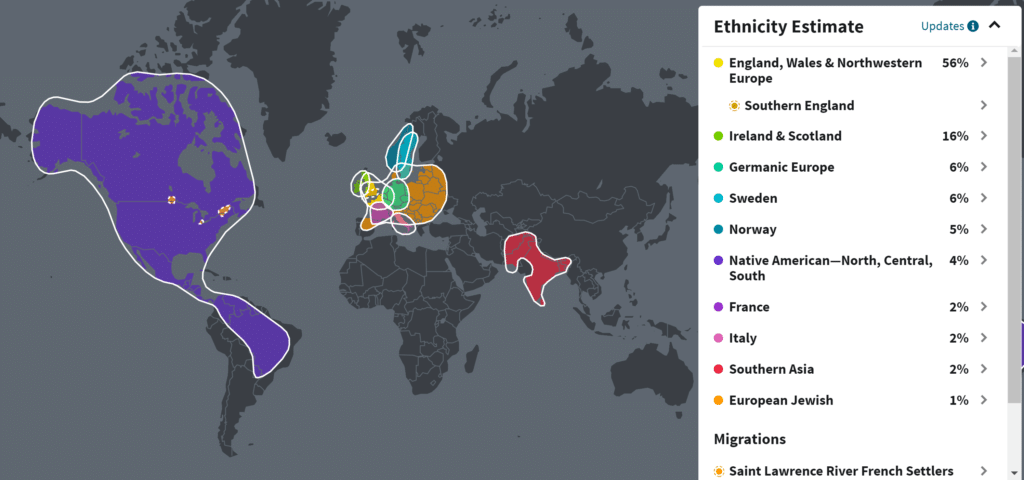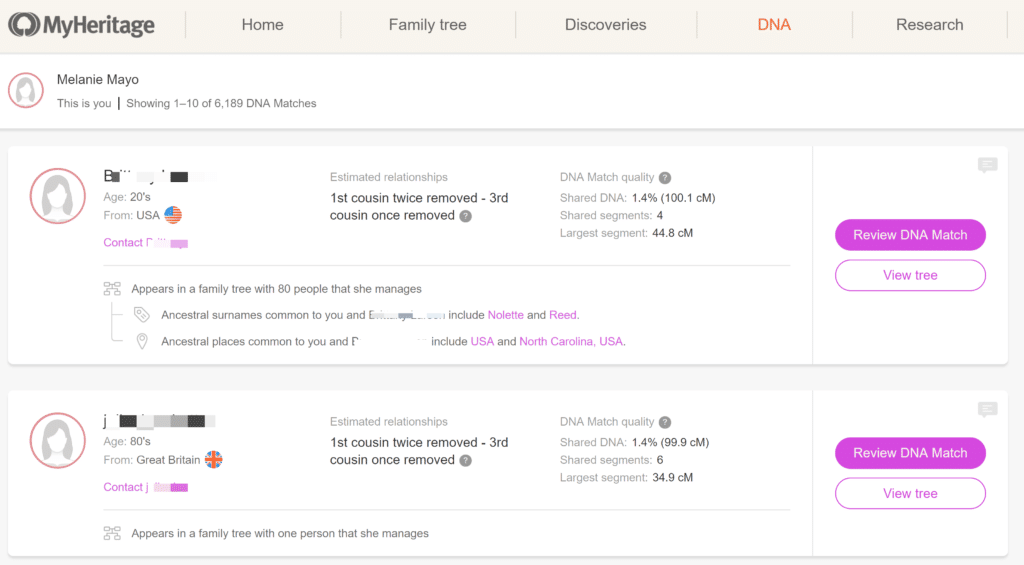If you’re one of the millions of people who received a DNA test kit for the holidays this year, you’re probably pretty excited to send in your sample and receive your results.
It’s pretty thrilling, after all, to finally discover how much Irish you really are, or if Grandma Jane was right when she said you have a distant Native American ancestor. You might even be hoping to connect with lost relatives.
And, of course, if you have been researching your family tree, you are likely eager to figure out how these new results can help you with your research.
But, if you’re not familiar with how these tests work you might also be feeling some confusion and trepidation.
What can you expect when you spit in that little tube, or scrap the inside of your cheek, and mail it off to the lab? Can the testing companies really use this sample to tell you where your ancestors came from? Will the results be accurate and easy to understand? Do you also need to build a family tree? Should you wait until your results come back, or start now?
Never fear, we’re here to help you answer some of these common questions so that you’re fully prepared to make sense of your results when they finally appear in your inbox. Here we go.
6 Common Questions About DNA Testing Answered
1. What should I do with the DNA kit I received?
The first thing to remember when you receive a DNA kit as a gift is that, just because someone was kind enough to share a test with you, it doesn’t mean that you need take it. While we’re big fans of DNA testing for genealogy, it’s not for everyone. If you have concerns or feel uncomfortable with testing don’t let anyone pressure you into doing it. You can always donate your kit to someone who is interested.
To help you decide, we suggest that you take the time to read and understand the privacy policies of the company you are testing with before mailing your sample. These can be found on the company’s website and are often presented during registration of the kit.
When you’re ready to go ahead and send off your sample, simply open the box or bag your kit came in and follow the included directions. While each test is different, there are some key elements that remain the same.
First, you will need to register your kit. This in a very important step because doing so will allow the company you are testing with to assign your sample to you and provide you with the results.
Simply visit the URL provided by the testing company or visit their website and look for a link that says register or active a kit. Now, type in the long code provided on your sample tube and use it to register and create an account with your email address.
When setting up your account pay attention to the options provided as they will determine what permissions you are granting the testing provider over your sample and results associated with it.
Once you have done this, you are all ready to create and send your sample. You will either spit into a tube or scrape your cheek to produce this sample (sometimes placing it in a solution) and then seal it up and mail it back in the postage paid envelope. Once you drop it off in the mailbox you’re on your way.
2. How long will I need to wait for my DNA results?
The average time to receive results is 4 to 6 weeks, but can vary widely by company and time of year. Busier times of the year, such as the months following the holidays, can mean longer wait times and 8+ weeks is not unheard of.
Kits are generally processed in the order they are received so it is a good idea to mail off your sample as soon as possible to secure your place in line. Once you have mailed off your package you can track your kit’s progress and will receive an email when your reports are finally ready.
Tip: If you are very eager to see your results keep an eye on your account (the one you created when you registered your kit). Often, reports will appear there many hours or even days before you receive the email announcing that your results are in.
3. Are there any costs associated with viewing my results?
If you received your kit as a gift you may be wondering if you will be required to pay any fees or sign up for any services to view or interpret your results. The answer is no.
Every one of the main testing companies – Ancestry, MyHeritage, Family Tree DNA, 23andMe and LivingDNA – provide all results as part of the cost of the kit. This includes your ethnicity report (a breakdown of the geographic ancestral regions you match) and matches with relatives (if provided as part of the service).
However, some companies – namely Ancestry and MyHeritage – are also in the business of offering genealogy record subscriptions and may limit some additional results and tools to those users who are subscribers. Still, you will be able to view your main results without signing up for any additional services so don’t feel pressured to do so if you are not interested in investing in family history research.
4. What will my results tell me? Will they tell me who my ancestors were and where they came from?
This is one of the most common questions we hear from those new to DNA testing. Many people face confusion about what to expect from their results. Generally, you will receive some or all of the following results when your sample is processed:
An ethnicity report (like the one shown below) that provides a breakdown of the geographic locations and populations your genes most closely match. This is the report most people are excited about. You will likely encounter some surprises when you first view this report as expectations and reality don’t always match up. What your results can NOT tell you is who your ancestors are. You will need traditional family history research for that.
We suggest you read What You Will and Will Not Learn by Taking a DNA Test for Ancestry for more help understanding what these reports can tell you. You can also view a sampling of what ethnicity reports from different companies look like here.
Matches with genetic relatives is another aspect of almost all testing companies (an example of MyHeritage’s cousin matching area is shown here).
These matches can be close relatives who have also tested, or more distant relatives who share a common ancestor. Many people like to connect with relatives since they can provide critical information to help with your family history research or, if they are more closely related, stories about shared relatives.
This aspect of DNA testing is optional and most services let you opt out. If you choose to use this service you will usually only be sharing a limited amount of your results with others you match, as well as your email address. Look for settings in your account if you want to turn this feature off. LivingDNA does not currently offer matches as all.
Help for understanding cousin matching relationships can be found in this article.
mtDNA and Y-DNA results are also offered by several companies and you may be able to view these as well. The ancestry tests most people are sharing this holiday season are autosomal, meaning that results are drawn from segments across all of your chromosomes.
mtDNA and Y-DNA, on the other hand, only show results for your direct maternal (mtDNA) and paternal (Y-DNA) lines. Only men have a Y chromosome so don’t expect this result if you are a woman.
Currently LivingDNA and 23andMe offer basic mtDNA and Y-DNA results as part of their main autosomal test and Family Tree DNA offers them (in a more advanced form) as a separate test. You can read more about the different types of testing here.
5. Are my DNA results accurate? What if my results seem wrong?
Many people, upon receiving their results, are shocked to find that they do not align with what they know about their family’s history. This is true for genealogists and non genealogists alike.
The truth is, while your genes don’t lie, interpretations are limited by available technology. This can be an even more confusing issue when someone chooses to test with more than one company. Since each uses their own unique (albeit similar) methods, your results can vary widely.
The important thing to remember is that your results should not be taken at face value, or too literally. Peoples of the world mixed readily and it can be very difficult to differentiate one from another.
If you were, as an example, expecting a large amount of German and end up with a large amount of Scandinavian instead, take some time to understand why this might be (geographically similar regions, mixed peoples, limitations of samples etc). Usually with some reasonable interpretation you can make some sense of what you are seeing.
Highly unexpected results (especially small percentages) can be an error or noise, but they may also be clues to mysteries in your family’s past.
As technology changes you will see your results change, getting more specific. Different companies will also provide vastly different interpretations of your data. Expect this and keep copies of past results to compare.
To better understand how to interpret your results read this in-depth article: Why You May Be Reading Your DNA Results All Wrong.
6. Do I need to start a family tree?
DNA testing and family history research are not one and the same. You will not get the same information from spitting into a tube as you will from genealogical research. Additionally, DNA results viewed outside of the context of a family tree are not nearly as interesting or informative.
The absolute best way that you can make the most of DNA results is by having a solid understanding of your family’s past, and the best way to do that is by starting a family tree and taking the time to fill it out.
If you don’t mind spending a little money, and received an Ancestry or MyHeritage DNA test, you might like to stay with that service. Start a tree there and get a subscription. This will give you a nice quick start to your research as you enter what you know and start getting hints to help. You’ll have the added benefit of being able to combine this research with your test results.
On the other hand, if you are on a tight budget, or prefer to branch out beyond these large companies, you might like to read our recent article The Zero Dollar Genealogist for how to get started with your research without spending any additional money.
Either way, create a tree, add what you know and start looking for record sources. As you do, your tree will grow and you will be much more prepared when your results come in.
Some people think that they should wait for their results before beginning a tree, but this is not necessary or recommended. Remember, a DNA test can not tell you who your ancestors were. It can only provide general information about populations you most closely match genetically. Count on traditional genealogy research, which is fun and rewarding, to provide the juicy details. The sooner you start the better.
You might like to read our beginner guides here or take an online genealogy course, which will walk you through getting started with genealogy research step by step.
By Melanie Mayo-Laakso, Family History Daily Editor


